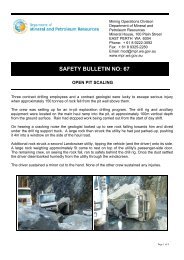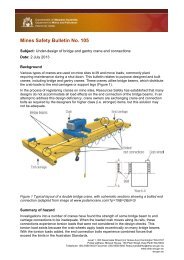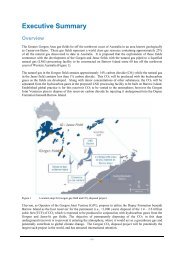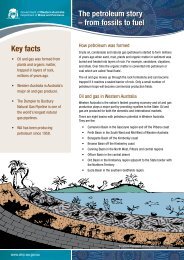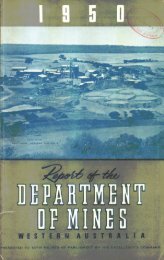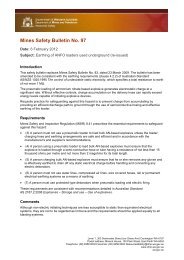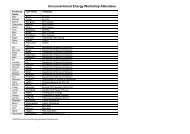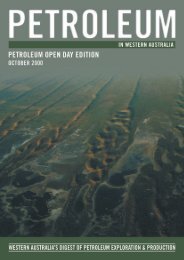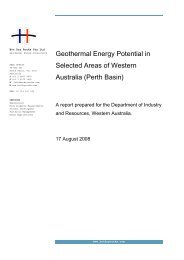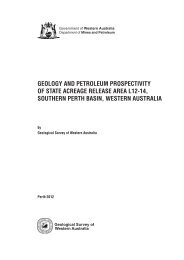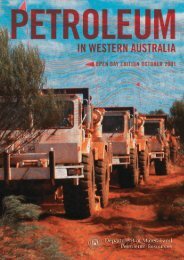IN WESTERN AUSTRALIA - Department of Mines and Petroleum
IN WESTERN AUSTRALIA - Department of Mines and Petroleum
IN WESTERN AUSTRALIA - Department of Mines and Petroleum
You also want an ePaper? Increase the reach of your titles
YUMPU automatically turns print PDFs into web optimized ePapers that Google loves.
34<br />
PWA April Edition - Coal Seam Methane<br />
Darren Ferdin<strong>and</strong>o<br />
Research Geologist, Resources Branch<br />
Coal seam methane (CSM; also known as coal<br />
bed methane - CBM, <strong>and</strong> coal seam gas - CSG),<br />
is a naturally occurring hydrocarbon that is<br />
generated <strong>and</strong> reservoired within coal seams. The<br />
methane gas is generated either through biogenic<br />
activity in near-surface coals or through<br />
thermogenic activity for deeper coal bodies. The<br />
generated methane is held within the coal by<br />
burial <strong>and</strong> hydrostatic pressure in a process<br />
known as adsorption.<br />
Coal seam methane over the last ten years has<br />
become a significant source <strong>of</strong> sales gas across<br />
eastern Australia. In Queensl<strong>and</strong> for example, nearly<br />
80% <strong>of</strong> the petroleum wells drilled last year were<br />
for CSM operations. Total Queensl<strong>and</strong> CSM<br />
production in 2002/03 is estimated at 25 PJ, which<br />
equates to almost 25% <strong>of</strong> Queensl<strong>and</strong>’s current gas<br />
dem<strong>and</strong> - this is an increase from 2 PJ in 1998 <strong>and</strong><br />
11 PJ in 2001. In New South Wales, CSM<br />
operations accounted for all the petroleum wells<br />
drilled in the State. In 1999/00 the gross value <strong>of</strong><br />
CSM operations in NSW was reported by the NSW<br />
<strong>Department</strong> <strong>of</strong> Mineral Resources at $18.56 million<br />
<strong>and</strong> the value <strong>of</strong> production is expected to increase<br />
to increase by at least 5% annually for the next ten<br />
years, with a new CSM operation well at Camden<br />
due to be commissioned soon. By 2020 it is<br />
estimated that CSM will account for 100 PJ/annum<br />
<strong>of</strong> energy production in eastern Australia, with<br />
Queensl<strong>and</strong> accounting for 60% <strong>of</strong> this <strong>and</strong> New<br />
South Wales the remaining 40%. ABARE has<br />
estimated a 3% annual growth in natural gas<br />
consumption until 2020, increasing from 521 PJ<br />
(17% <strong>of</strong> Australia’s total energy consumption) to<br />
974 PJ in 2020 equating to nearly 20% <strong>of</strong><br />
Australia’s energy consumption. CSM operations<br />
have the potential to contribute to an increasing<br />
proportion <strong>of</strong> this natural gas consumption.<br />
Coal Seam Methane - what’s the gas?<br />
At present there are no commercial CSM operations<br />
in Western Australia; however, the level <strong>of</strong> CSM<br />
exploration in the State has increased over the last<br />
two years. In response to this, the <strong>Petroleum</strong> <strong>and</strong><br />
Royalties Division <strong>of</strong> DoIR is commencing a study<br />
into the CSM potential <strong>of</strong> Western Australia to assist<br />
explorers in this field find appropriate acreage in the<br />
State. This article intends to provide a broad<br />
overview <strong>of</strong> CSM operations <strong>and</strong> the regions <strong>of</strong> the<br />
State that may be prospective for CSM.<br />
Differences between conventional gas <strong>and</strong> CSM<br />
All the gas currently produced in Western Australia<br />
comes from ‘conventional’ gas plays where gas has<br />
been generated at depth in organic-rich claystones<br />
or shales <strong>and</strong> migrated along permeable rock beds<br />
into an area that has effectively trapped the gas; for<br />
example, through sealing the permeable rock<br />
against impermeable rock by faulting; or in creation<br />
<strong>of</strong> domal structures through folding <strong>of</strong> the<br />
permeable rocks that the gas is then trapped in.<br />
Coal seam methane operations involve extracting<br />
methane gas from subsurface coal accumulations.<br />
While it is possible to extract methane from shallow<br />
coals, such as those mined from the Collie coalfields<br />
in the southwest <strong>of</strong> Western Australia, the production<br />
rates from these deposits tend to be noncommercial.<br />
For optimal methane production rates,<br />
coal seams generally need to be at a depth <strong>of</strong><br />
between 500 to 1200 m. The maximum depth <strong>of</strong><br />
burial for coal seam methane production (at<br />
commercial rates) appears to be about 1200 to 1500<br />
m, although some wells produce methane at greater<br />
depths. The minimum depth <strong>of</strong> burial is about 200 to<br />
300 m, depending on the sealing efficiency <strong>of</strong> the<br />
overburden. These are depths at which coal mining is<br />
uneconomic – thus these two uses <strong>of</strong> coal for energy<br />
are not competing for the same resource.<br />
Coal has an extremely large internal surface area<br />
due to its enormous micropore surface area, <strong>and</strong> as<br />
such it can store surprisingly large volumes <strong>of</strong><br />
methane-rich gas; six or seven times as much gas<br />
as a conventional natural gas reservoir <strong>of</strong> equal rock<br />
volume can hold.<br />
One <strong>of</strong> the greatest advantages associated with the<br />
coal seam methane resource relative to<br />
conventional gas is that the size <strong>and</strong> extent <strong>of</strong> the<br />
coal deposits, along with the gas content <strong>of</strong> the<br />
coal, can be estimated with a reasonable degree <strong>of</strong><br />
accuracy before major investments are made.<br />
Technical issues for CSM exploration <strong>and</strong><br />
production<br />
The technical considerations in determining whether<br />
a CSM prospect will be commercially viable are<br />
quite different than those used in making such<br />
determination for conventional gas prospects. Key<br />
factors that affect gas flow rates in coal seam<br />
methane projects include the absorption properties<br />
<strong>of</strong> the gas, presence <strong>of</strong> fracturing <strong>and</strong> permeability.<br />
Biogenic vs thermogenic methane<br />
Coal seam methane can be generated through two<br />
distinct mechanisms. The first is generation <strong>of</strong><br />
methane through thermogenic breakdown <strong>of</strong> the<br />
carbon-rich material in the coal due to burial <strong>of</strong> the<br />
coal seam. Thermogenic methane generation<br />
usually occurs at depths <strong>of</strong> greater than 300 m. The<br />
second mechanism for methane generation from<br />
coal seams relies on methane being generated from<br />
bacteria found within the coal at generally shallow<br />
depths (up to 500 m). Research has indicated that<br />
biological methane generation can be very rapid in<br />
low-rank coals such as those found in Western<br />
Australia. This biological gas generation is so rapid<br />
that it is technically feasible to generate usable gas



